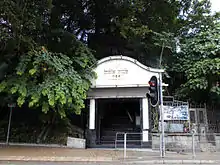Gascoigne Road
Gascoigne Road (Chinese: 加士居道; Cantonese Yale: gaa1 si6 geui1 dou6) is a main road in Kowloon, Hong Kong, going west-east from Nathan Road to Chatham Road South through the head of King's Park, leading vehicles from West Kowloon to the Cross-Harbour Tunnel.
| Gascoigne Road | |||||||||||
|---|---|---|---|---|---|---|---|---|---|---|---|
 Gascoigne Road and flyover. | |||||||||||
| Chinese | 加士居道 | ||||||||||
| |||||||||||
.jpg.webp)




Gascoigne Road Flyover (加士居道天橋) is a 1.2 km (0.75 mi) long flyover linking between Gascoigne Road and Ferry Street, passing through Yaumatei Carpark Building.[1] Built in 1977, it is part of the West Kowloon Corridor.
History
The road was laid out after 1901 and named after William Julius Gascoigne,[2] Commander British Troops in China and Hong Kong from 1898–1903. It was reported in 1908 that "All the roads on the [Kowloon] peninsula are wide and lined with trees, and two in particular—Robinson Road [today's Nathan Road] and Gascoigne Road—are noticeable by reason of their width" and "Gascoigne Road, which is 100 feet wide, runs right across the peninsula from Hunghom to Yaumati, and skirts the King's Park, a large enclosure reserved for recreation, and the United Services Recreation Ground."[3]
The Fronde Memorial, a granite obelisk, was erected in May 1908 in memory of the five sailors of the French Arquebuse-class destroyer Fronde who disappeared in the sinking of their boat near the Torpedo Depot, Kowloon, during the 1906 Hong Kong typhoon. Initially erected at the corner of Gascoigne Road and Jordan Road, the monument was relocated to Hong Kong Cemetery in Happy Valley[4] during the 1960s.[5] The Fronde was later salvaged, repaired in the Hung Hom shipyard, and left Hong Kong in March 1907. It was active during World War I and was decommissioned in 1919.[6]
Gascoigne Road was widened in 1988 and the adjacent slope near the Queen Elizabeth Hospital was cut back. A 12m high rock-socketed caisson retaining wall was constructed to support the cutting.[7]
Features
Northern side of the road: (from east to west)
- Headquarters building of the Hong Kong Girl Guides Association (#8)[2]
- Club de Recreio (西洋波會) (#20). The Club was founded in 1911 by prominent members of the Portuguese community in Hong Kong. The present clubhouse was built in 1928.[8] Grade III historic building.[2][9]
- YMCA King's Park Centenary Centre (#22)
- India Club (印度會) (#24). The present clubhouse building was built in 1956.[10] Grade III historic building.[2][9]
- Queen Elizabeth Hospital (#30)
- Hong Kong Labour Tribunal (#36)
- Old South Kowloon District Court (#38). Grade I historic building.
- Kowloon Methodist Church (循道衛理聯合教會九龍堂) (#40). Erected between 1950 and 1951, it is the largest church building of the Methodist Church in Hong Kong.[11]
- Methodist College (Kowloon) (#50). The campus includes the buildings of the former Grantham College of Education, which was located at No. 42 Gascoigne Road.
- Former access to an air raid precaution (ARP) tunnel. Near the junction with Nathan Road.[12][13][14]
Southern side of the road: (from east to west)
- Gun Club Hill Barracks
- United Services Recreation Club (USRC; 三軍會) (#1). Opened in 1911 as a British military club, it is now owned by the People's Liberation Army, but administered as a limited company with a wholly civilian membership.[2][15]
- Diocesan Girls' School
- Eaton Hotel Hong Kong
References
- Highways Department: Widening of Gascoigne Road Flyover. Project profile. September 2006
- Wordie, Jason (2007). Streets: Exploring Kowloon. Hong Kong University Press. pp. 70–74. ISBN 9789622098138. Retrieved 16 August 2014.
- Wright, Arnold (1908). Twentieth century impressions of Hong-kong, Shanghai, and other Treaty Ports of China. London: Lloyd's Greater Britain Pub. Co. p. 156. Retrieved 17 August 2014.
- Patricia Lim (2011). Forgotten Souls: A Social History of the Hong Kong Cemetery. Hong Kong University Press. p. 448. ISBN 9789622099906. Retrieved 16 August 2014.
- France – Hong Kong, 160 ans d'histoires: "Le monument perdu et… retrouvé de la «Fronde»", 17 November 2008. (in French)
- France – Hong Kong, 160 ans d'histoires: L’épopée de la «Fronde». 19 January 2009.(in French)
- Ho, K.K.S.; Mak, S.H. (1 January 2001). "Performance monitoring of a rock-socketed caisson wall". In Ken K. S., Ho; K. S., Li (eds.). Geotechnical Engineering – Meeting Society's Needs. Volume I. CRC Press. pp. 315–320. ISBN 9789058092564.
- Brief Information on proposed Grade III Items. Item #684 Archived 22 September 2013 at the Wayback Machine
- List of the 1,444 Historic Buildings in Building Assessment (as of 27 December 2013)
- Brief Information on proposed Grade III Items. Item #925 Archived 22 September 2013 at the Wayback Machine
- Brief Information on proposed Grade III Items. Item #767 Archived 22 September 2013 at the Wayback Machine
- Hong Kong Telegraph, 12 October 1940, reported in gwulo.com: "Life in Hong Kong's ARP tunnels"
- gwulo.com: "ARP portal on Gascoigne Road"
- hk-place.com: 加士居道防空隧道
- History of the USRC
External links
| Wikimedia Commons has media related to Gascoigne Road. |
- Google Maps of Gascoigne Road
- (in French) More details about the Fronde incident:
- Information and pictures of the Fronde monument: